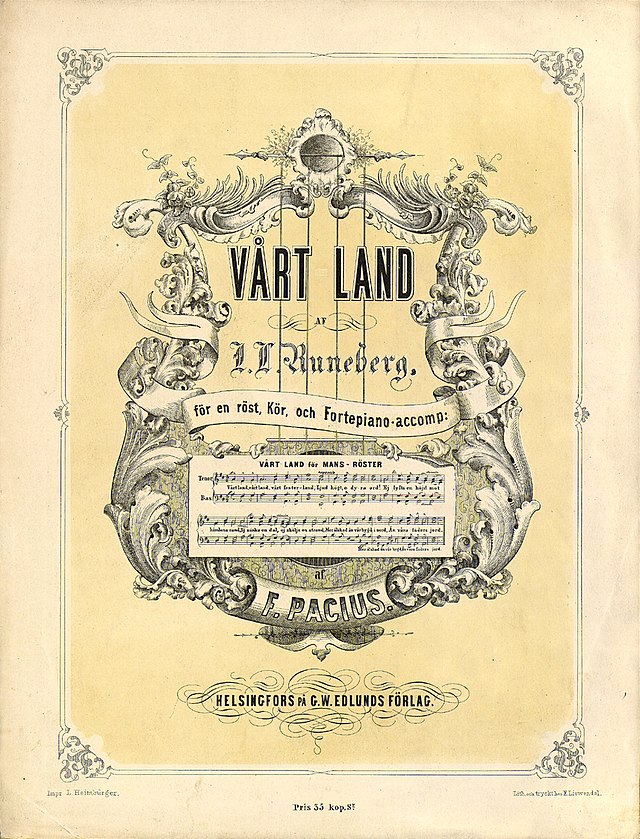Loading AI tools
National anthem of Finland From Wikipedia, the free encyclopedia
"Maamme" (Finnish: [ˈmɑːmːe]; Swedish: Vårt land, Finland Swedish: [ˈvoːrt ˈlɑnːd]; both meaning "Our Land") is the de facto national anthem of Finland.[1][2] The music was composed by the German immigrant Fredrik Pacius, with original Swedish lyrics by Johan Ludvig Runeberg. It was first performed with the current melody and lyrics on 13 May 1848.[3] Originally, it was written for the 500th anniversary of Porvoo, and for that occasion it was Runeberg himself who wrote the music.
You can help expand this article with text translated from the corresponding article in Finnish. (June 2018) Click [show] for important translation instructions.
|
| English: Our Land | |
|---|---|
 The first stanza of "Maamme" from the Finnish translation of The Tales of Ensign Stål | |
De facto national anthem of Finland | |
| Also known as | "Vårt land" (English: "Our Land") |
| Lyrics | Johan Ludvig Runeberg, 1848 |
| Music | Fredrik Pacius, 1848 |
| Adopted | 1917 |
| Audio sample | |
U.S. Navy Band instrumental version (one verse) | |
The melody of "Maamme" is also used for the national anthem of Estonia with a similarly themed text, "Mu isamaa, mu õnn ja rõõm" ("My Fatherland, My Happiness and Joy", 1869).[4] It is also considered to be the ethnic anthem for the Livonians as "Min izāmō" ("My Fatherland").


The original poem, written in 1846 but not printed until 1848, had 11 stanzas and formed the prologue to the verse cycle The Tales of Ensign Stål ("Fänrik Ståhls sägner"), a classic example of Romantic nationalism. The current Finnish language text is usually attributed to the 1889 translation of Ensign Stål by Paavo Cajander, but in fact, originates from the 1867 translation by Julius Krohn.[5][6]
In the 1880s and the 1920s, there were more attempts to replace it with a Finnish language version but these ceased by the 1930s.[7] Some Finns have proposed that the Finnish national anthem be set as "Finlandia" by Jean Sibelius,[8] with lyrics by V.A. Koskenniemi (Finnish) and Joel Rundt (Swedish).
It is said that Pacius composed the tune in four days. It was popular throughout the 19th century but established its current position only after Pacius' death.[9]
There is no law regarding an official national anthem in Finland, in the way the coat of arms and flag of Finland are legally defined. Instead, its position has been established gradually by convention over the years.[4] In 2018, "Maamme" was described by the Government of Finland as the "Finnish national anthem".[10]
Even though "Maamme" has become established as the de facto anthem, its status has still been debated from time to time.[11] It has been suggested that the status of "Maamme" as the national anthem should be legalised. For example, opposing legislative initiatives were made in 2003 by the Finnish Parliament to make "Maamme" and the Finlandia Hymn the official national anthem.[12][13] In 2014, there was a citizens' initiative about choosing the Finlandia Hymn as the national anthem,[14] and in 2016 members of the National Coalition Party began campaigning to stop using "Maamme" in favour of the Finlandia Hymn, however, opinions were not unanimous in the party,[15] and the campaign fell short of its goal.[16]
Despite the lack of official status, in usage, "Maamme" fills the function of a national anthem in the same way as in many other countries. For example, it is played during state visits,[17] and used to represent Finland at international sporting fixtures.[18]
In 2024, the Indonesian composer and pianist Ananda Sukarlan wrote "Findolandesia" for violin and piano. The piece was written to celebrate the 70th anniversary of the diplomatic relationship between Finland and Indonesia. "Findolandesia" intertwines melodies from "Maamme" and "Tanah Airku", a patriotic Indonesian song by songwriter Saridjah Niung and then made into a kind of fantasy / variations on the original motifs. It was premiered by the composer on the piano and young Indonesian violinist Aurell Marcella in Jakarta, in a concert hosted by Bimasena and the Finnish Embassy in Jakarta.
The original lyrics consist of eleven verses, but it is customary to only sing the first verse and the last verse unless the people gathered are mixed Finnish- and Swedish-speaking. In the latter case, three verses are sung: the first in Finnish, the first in Swedish and the last in Finnish.[citation needed]
| Swedish original[19] | Finnish version[20] | English translation from Swedish[21] |
|---|---|---|
I |
I |
I |
| Swedish IPA transcription[a] | Finnish IPA transcription[b] |
|---|---|
1 |
1 |
Seamless Wikipedia browsing. On steroids.
Every time you click a link to Wikipedia, Wiktionary or Wikiquote in your browser's search results, it will show the modern Wikiwand interface.
Wikiwand extension is a five stars, simple, with minimum permission required to keep your browsing private, safe and transparent.